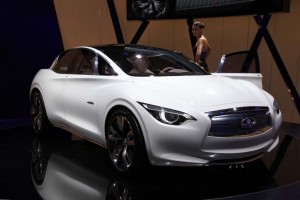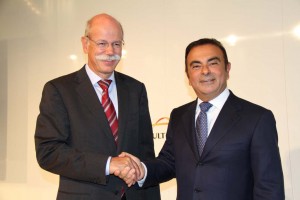
Infiniti will use a Mercedes-Benz platform when it goes to production with a compact luxury car based on the striking Etherea concept vehicle.
The all-new Mercedes-Benz B-Class platform will be shared with Infiniti which plans to use it as the foundation for a compact luxury offering based on the popular Etherea concept car.
That’s the latest move to emerge from a rapidly expanding alliance between Mercedes’ parent Daimler AG and erstwhile rivals Nissan and Renault, which have made a successful go of their own Euro-Asian alliance.
In an unusual joint appearance, Daimler CEO Dieter Zetsche and Renault-Nissan Chief Executive Carlos Ghosn provided an update on their 18-month-old strategic partnership and gave a sense of where they hope to go next.
The three companies will soon begin sharing powertrains, as well as an assortment of vehicle platforms. But among other things, they are looking at the possibility of pooling efforts on the development of zero-emissions vehicles, the two CEOs suggested.
“We probably haven’t seen as much change in our industry in decades as we have to face now,” said Zetsche in explaining why Daimler, Nissan and Renault have chosen to work together. So, he added, “By doing (things) together in certain areas we will get even stronger.”

Daimler CEO Dieter Zetsche and his Nissan-Renault counterpart Carlos Ghosn during a Frankfurt Motor Show news conference.
The partnership was originally formed to focus on three strategic needs: small and medium powertrains, a compact commercial van and the development of new microcar offerings for Daimler’s Smart line that would also serve as an update for the pint-sized Renault Twingo.
But “Our cooperation is moving on the fast track and is now expanding,” emphasized the Brazilian-born Ghosn, who is credited with the unexpected turnaround of Nissan over the last decade.
Finding a way to update the Smart line-up was critical for Daimler, which has struggled to justify the expense of the long-struggling brand. In the U.S., sales of the Smart fortwo have collapsed since its 2008 introduction largely due to its dated technology. But Daimler is hoping for a turnaround in the States – and other parts of the world when Smart updates its product line-up before mid-decade.
The new Smart line – like the updated Twingo – will rely on a mix of new 3- and 4-cylinder engines developed on the Nissan-Renault side of the strategic partnership. The 4-cylinder powerplant “will be available,” said Zetsche, “when we launch the new A-Class” in about a year.
But Mercedes is, in turn, planning to provide V-6s that will soon wind up in some of the Nissan-Renault products, including the Infiniti brand.
Infiniti, in fact, could be a real winner if the partnership continues to prosper. At this week’s Frankfurt Auto Show, Mercedes unveiled its new B-Class crossover. The underlying platform, known by the codename MFA, will go into at least five different Mercedes models eventually – and probably more.
But the partners have now agreed that MFA will also be shared with Nissan’s Infiniti brand, providing it a cost-effective alternative to develop the compact luxury platform it has needed. Ghosn, speaking in Frankfurt, confirmed that this new model, based on the striking Etherea show car, will reach market, also before mid-decade.
The production Etherea will likely be offered in both hatchback and sedan body styles, according to Infiniti. Specific details, including the site of production, have not yet been determined. But Ghosn stressed there is “no way” the compact luxury model will be produced in Japan because of the economic challenges of a yen that is now trading at just 77 to the dollar.
Both makers are spending billions of dollars on their various R&D programs and finding ways to cooperate will only leverage those investments, asserted Zetsche. That’s especially true when it comes to zero-emissions programs, added Ghosn.
They are testing the waters of cooperation there. The partners have already agreed that Nissan will provide the driveline, including the motor and power electronics, for the next-generation Smart Electric Drive battery car. Daimler will use batteries in produces in-house. It will also provide those batteries for a Twingo battery car.
This could lead to other zero-emissions joint ventures, the two executives agreed.
Beyond that? “There are no off-limit projects,” said Ghosn. Additional luxury products could be in the mix, for example. At the next strategy meeting, the partners even plan to consider the potential benefits of joint advertising purchases.
The apparent, if early, success of the strategic partnership stands in stark contrast with recent realities within the auto industry. A number of other alliances have collapsed, often catastrophically. Volkswagen and Suzuki are now unwinding from one such venture. Nissan saw an earlier effort to team up with Volvo falter, while Daimler had a textbook failure in its “merger of equals” with America’s Chrysler.
What’s different with Daimler, Nissan and Renault?
“What we did there (with Chrysler) is the exact opposite of what we’re doing here,” said Zetsche. Only after completing the merger, in 1998, did Daimler and Chrysler really get down to the specifics of seeing what they could do together and how. It resulted in plenty of resistance and the eventual failure of their partnership.
The new alliance is more limited and focused on individual projects, the German executive explained, so “We have a clear understanding of what we want to do together.”
But hard facts aren’t always enough, and in a follow-up conversation, Ghosn told TheDetroitBureau.com that, “The chemistry between people is very important,” and those close to the venture report a very collegial relationship between Zetsche and Ghosn.
In the long run, however, leaders change while the hope is that successful business ventures continue. So, said the Nissan-Renault boss, it’s important to create effective practices for moving the tie-up forward. “When processes are in place, that chemistry is less important.”
